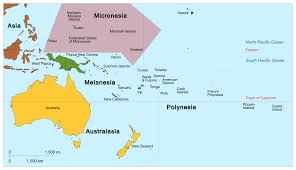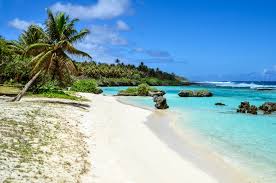Praxis II Study: Oceanic Art
- Olivia Smith

- Apr 2, 2020
- 3 min read
The Praxis II is coming up very soon for me! Recently, I took a practice test to assess my knowledge of the content. Let's just say I could've done better... But hey, I will get there and so will you, as long as we keep studying! I figured I would make a blog post every time I study, so I can share with you what I learned.
I found that I need to study more art beyond the Western Tradition; that includes regions like Asia, Africa, the Americas, the South Pacific Region, etc). Today we are going to travel to a lovely place called Micronesia...
Micronesia is a country in the western Pacific Ocean made up of many islands. Since it is surrounded by water, the Micronesian people were very accomplished voyagers and the ocean was always extremely important to them. The ocean played a big role in their lives, not only because they needed it for travel, but it was also used for fishing, and for trade networks and political alliances. Some of the artworks that came from Micronesia in the early 19th century were directly associated with the ocean. Things like weather charms and stick charts are now considered artwork, but back then had some functionality.
Weather Charms
These voyagers often times faced extreme weather when traveling, storms that could leave them stranded or dead. Because of this, they decided to use "weather magic." Weather magic was something they believed would "alter the path of approaching storms." One of the charms possessing weather magic was the hos, which was a wooden figure with legs made from the spines of stingrays, believed to be the source of its weather powers. To ignite this power, the voyagers would hold the hos and recite a chant while playing a shell trumpet to summon the spirits, and then drive away the approaching storms. The charm would then be brought aboard and kept in it's own little house, only to be taken out again if the bad weather reappeared.
The hos, which can be seen below, is a small figure carved from wood. It resembles a human figure, but is very minimal in terms of features. The mix of the solid figure with the sharp stingray spines creates a very powerful aesthetic.

Stick Charts
Because traveling was so big, navigation was essential for voyagers to get where they needed to go. Back then there was obviously no technology like we use today, but they were very creative. Navigators would construct diagrams "representing different portions of the archipelago." These diagrams were made out of midribs of coconut palm fronds. They were apparently only allowed to be used on land before a voyage, because using them while at sea would show a lack of skill and knowledge. These charts show positions of islands and features of the sea. Navigators would use these to show the patters of ocean swells.
At first glance I personally see this as an abstract art piece , I never would have assumed it had such a complex story behind it. I definitely am not able to read it the way it was intended, but I think that makes it that much more fascinating.

Prompts
Now it's your turn to find some inspiration from these beautiful pieces. Because of recent events, we will make it a little bit different. I challenge you to create a COVID-19 charm to ward off sickness and bad luck during this scary time. You may use any materials you can find!
Next, if you are bored and you have someone there with you, try creating a stick map out of natural materials (sticks maybe..?) and challenge whoever you are quarantined with to figure out and follow the map to find something you've hidden for them. Good luck, and thanks for studying with me!










Comments